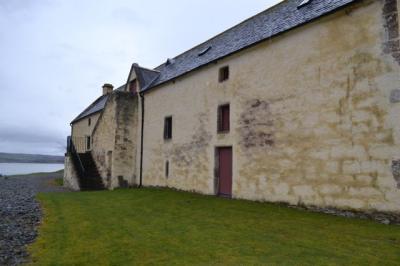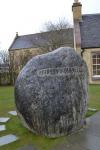Categories
The Storehouse of Foulis
by Nadine Lee

Sitting on the banks of the Cromarty Firth between Evanton and Dingwall, the Storehouse of Foulis is a fully restored 18th Century building that once housed the rent paid in kind from the Munro estate. Once only visited by horse and cart, the Storehouse now sits alongside the busy A9 with cars zipping past on the main road in and out of the Northern Highlands.
Thought to have been completed around 1740, the Storehouse was built for the Munros of Foulis at a time when rent on the estate was largely paid in goods. The area surrounding Foulis provided good growing and farming conditions because of the rich soil and relatively mild temperatures. Oats and barley received from the tenants were stored here before being portioned out to farm workers and household staff as wages. Surplus goods were shipped off to markets further south via ferry. The Storehouse is positioned towards the sea on the gently sloping shore just above high-tide mark so boats could be safely beached to load goods, floating away on the next incoming tide.
Surviving documents show the export of grain and foods such as salt salmon as well as timber sent by sloop to Fort George in 1753. A letter from Sir Hugh Munro to his factor in October 1795 stated that tenants should be given a receipt for grain brought to the storehouse, bringing as much as they conveniently could at one time. On February 3rd 1796 at a time when oatmeal was scarce, a group over 150 people marched on the Storehouse. They believed it to hold stores of oats but, after threatening to break in to the building, a deputation was allowed in by the storekeeper. Finding only barley and wheat they refused to buy saying that they “… lived chiefly by oatmeal and they did not mind tho’ he should send away all the wheat and barley… provided he left the oats.”
The building is constructed of lime harled sandstone rubble masonry bonded by lime mortar with dressed stone margins around the openings and a Ballachullish slate roof – a fine example of vernacular architecture. All the windows are small with those on the ground floor mere slits to provide necessary ventilation for the grain, and to provide security for the goods stored inside.
By the early 19th Century most rents were being paid in money, but the Storehouse continued to be used to store bulky goods moving in and out of the estate by sea until well into the 20th Century. Today the wooden pillars, capitals and longbeams survive whilst the joists and planking date from the refurbishment in 1998. The building is now a visitor attraction run by Clan Munro, with the store house hosting information about the building’s history, the clan and the area’s wildlife. An accompanying restaurant and farm shop have been built next door, with fresh and local produce for sale. In 2010 Prince Charles visited the Storehouse as part of his role as founder of the North Highland Initiative, which aims to bring together the farming community, local businesses and the tourism industry to promote the economic development by creating and marketing a powerful North Highland brand.
You can view a gallery of images by clicking the link below.
Topics:
Cromarty Firth, Dingwall, Evanton, Foulis, Munro, North Highlands, Oatmeal Riot, Prince Charles, Sir Hugh Munro


